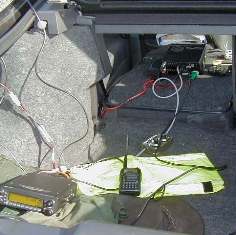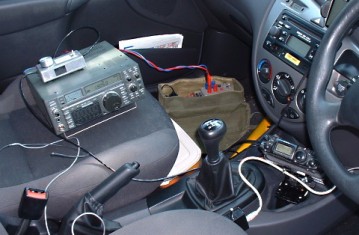

This page describes the steps necessary to set up an operational talkthrough unit using the DRAT interface.
Note that the operation of such a repeater unit into radiating antennas requires a special permit, issued to emergency communications groups (RAYNET).
As an example, we require a talkthrough from 70cm FM to 160m SSB. These are the steps needed to set up the correct levels:
1. Connect the DRAT interface unit to the rear of the two transceivers, making sure that the TX enable switch is off and both level controls are set to minimum. Also turn the squelch controls on both radios to maximum.
2. Tune the UHF set to the required frequency, and select the mode used for 1200 baud packet operation.
3. Tune the HF set to the required frequency, and select the mode used for PSK31 operation.
4. Turn on the TX enable on the DRAT unit. Neither radio should transmit at this stage.
5. Open the squelch on the UHF set. This should send the HF set into transmit, but with no signal going out.
6. While observing the ALC meter on the HF set, wind up the gain control on the DRAT unit to achieve the correct level. Now close the squelch on the UHF set.
7. Now switch the HF set to FM mode and open the squelch. This should send the UHF set into transmit.
8. While observing the modulation meter on the UHF set (see note below), wind up the gain control on the DRAT unit to achieve the correct level. Now close the squelch on the HF set and re-select the mode for PSK modulation.
(Note, if the UHF set does not have a modulation level meter display, it will be necessary to listen to its output on a second receiver, and set the modulation level by ear.)
Having completed these steps, the talkthrough unit is ready to use.
If RF feedback problems are encountered which distorts the modulation on SSB, try operating the two transceivers from separate DC supplies.
We have also seen a problem when operating a 160m transmitter with a "positive" squelch VHF set. In this case, the 160m TX "stuck" in the transmit mode on FM, even after the squelch closed on the VHF receiver. This was only observed when operating into a mobile antenna on 160m (not on a dummy-load), and is likely due to RF energy forward-biasing the DRAT switching transistor. Try decoupling the base-emitter junction of the BC546 in this case.
The pictures below show prototype units installed in vehicles, as operated by G4YNK and G6GVI.


The RAYNET permit requires that the unit is always supervised by an operator, who can take manual control if required. This may be done by switching off the TX enable, and using the microphones connected to each set (it may be necessary select FM and SSB modes on the radio to enable its microphone input).
The attendant operator can set the volume controls on the two sets for comfortable listening, without affecting the levels transmitted. He may need to adjust the modulation gains on the DRAT units if one of the stations operating through has particularly quiet or loud modulation. He may also need to adjust the squelch levels on each set as local noise levels vary.
In order for the squelch to operate on SSB modes, the "SQL/RF-G" parameter must be set to SQL (menu 45 in the FT817).
When using the audio interfaces in the rear panel DATA socket, we must operate the transceiver as it would be used in Digital modes, i.e.
To use FM modulation, set the PKT RATE menu to 1200, and select the PKT mode. Select the MOD meter when setting the modulation gain.
To use USB modulation, set the DIG MODE menu to PSK31-U, and select the DIG mode. Select the ALC meter when setting the modulation gain.
To use LSB modulation, set the DIG MODE menu to PSK31-L.
There are no special modes for using the rear panel socket, so we must operate the transceiver on FM or SSB modes. The front microphone socket remains active, so disconnect the mic, or set the mic gain slider down to minimum.
The modulation gain is much lower on FM, compared with SSB.
In order for the squelch to operate on SSB modes, the "RF GAIN" parameter must be set to OFF (Initial setup menu 20 in the mk1).
In the mkIIG model, the parameter is menu 7 "RF/SQL".
Note that the 13-pin socket on the back of the mk2 model has a different pin for PTT on 2m!
The mkIIG model has the 6-pin mini-DIN socket on the back (with negative-going squelch).
This is a VHF/UHF tri-band FM mobile transceiver.
Make sure that the band required for transmission is set on the right-hand side of the display, otherwise the rear-panel input doesn't work!
We have seen problems which may be due to fed-back RF energy when operating this into a mobile aerial on 160m. Tests are continuing.
Tests on one unit found that the SQUELCH output on the mini-DIN connector also goes high when the radio goes into transmit.
This is unsuitable for the simple DRAT circuit, as it causes the other radio to oscillate between transmit and receive modes.
A solution is for the DRAT interface to incorporate an extra N-channel MOSFET to gate the radio's squelch output with its PTT line. This circuit has been successfully tested with a TM-V7E radio.